Guides for Carcassing Timber & Plywood Sheets
What is a Furring Strip?
Firrings, or furring strips, are primarily used to create a subtle slope on flat roofs to help prevent water from pooling on the surface. However, their simple yet effective design means they can be utilised for a myriad of interior or exterior construction projects. This guide will explore what some of these lesser-known uses are, as well as the reasons behind firrings’ importance.

Contents
Intro
Furring strips are narrow pieces of tapered lumber that can be used for a variety of building jobs, however, they are most recognised for their role in roof construction. Without furring strips on roofs, rainwater would collect, settle and stay on top of roofs, causing water damage and leaving room for a multitude of other issues. However, furring strips are also great for other tasks, such as making space for insulation in a roof, or to level and resurface ceilings or walls.
*** This guide has been crafted to help you to understand the uses and characteristics of furring strips. All information provided is compliant with BS 6229:2018 recommendations, which is the British Standard that outlines the best current practice in the design, construction, care and maintenance of roofs with a flat or curved surface, at a pitch no greater than 10 degrees to the horizontal, with a continuously supported flexible waterproof covering. ***What is a Furring strip?
Furring strips, sometimes spelt as firring strips, are primarily used for the construction of a flat roof; they taper along their length, creating a subtle slop to allow rainwater to drain. Firrings are kiln-dried for extra stability and pressure-treated to create an enhanced resistance to water and damp and are typically milled from woods such as southern tallow pine, spruce or fir.
There are two main types of furring:
- Folding Pair
- Identical Pair
This type of furring is the most effective solution for long lengths. Cut from a single length of timber, the smaller ‘off-cut’ can be joined at the end of the larger one, creating one continuous length and essentially doubling the length of the stock timber:

Here, two furring strips are cut from a single length of timber, creating identical firrings. This is typically where you’d find most 0mm firrings; for example, a 50mm to 0mm furring would be cut from a 50mm stock, producing firrings that end in a 0mm thickness, however, they can also be cut so that their end gradient is not 0mm. This is a cost-effective way to purchase firrings:

What are timber firrings used for?
Firrings, or furring strips, are specialised pieces of wood, with benefits including…
- Consistent in size, length and gradient
- Made from durable and treated timber
- Often treated to help avoid decay

Due to their above-mentioned features, firrings are able to tackle many different tasks and are able to…
- Raise a surface
- Prevent dampness
- Make space for insulation
- Level and resurface walls
- Increase the beam of a wooden ship
- Hobbies, shelving, and general finish work
- Create an even, level surface to attach wallboard, panelling or siding

How to Make Furring Strips for Flat Roof
To avoid water pooling, a flat roof needs to be sloped to allow drainage. The NHBC (National House-Building Council) recommends different gradients and ratios for different types of roofing. Here is a summary of the different fall amounts to follow depending on your roof type or material:
| Roof Type | Notes | |
|---|---|---|
| Flat Roofs (Finished fall ratio: 1:80) | Where run-off may cause damage or staining to a façade or damage to landscaping, then rainwater gutters and downpipes should be provided. | 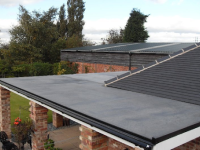 |
| Balconies (Finished fall ratio: 1:40) | The fall should be directed away from the door and have an outlet for rainfall. | 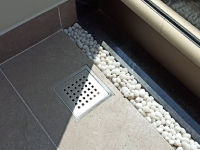 |
| Tapered Insulation (Finished fall ratio: 1:60) | Should be installed directly onto the vapour control layer, with the primary waterproofing above. | 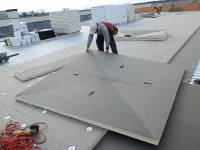 |
| Green Roofs (Finished fall ratio: 1:60) | You can effectively deal with large volumes of water by using an HDPE membrane as a drainage layer. | 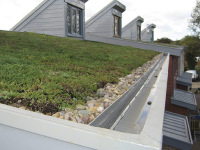 |
| Metal Sheet Roofs (Finished fall ratio: 1:60) | This applies to flat roofs that have metal sheet roof coverings. | 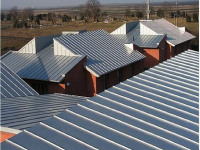 |
| Concrete Roofs (Finished fall ratio: 1:60) | Can be finished with sand or cement to achieve the desired fall which should be free from ridges and indentations. | 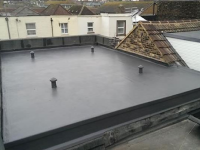 |
If you’re installing the furring strips yourself, make sure that the smaller side is the one pointing away from your building as furring strips are made to direct rainfall onto the ground and away from your roof!
Are Furring Strips Necessary?
Furring strips have crucial jobs and help to direct the water away from your roof and down either a gutter, spout, outlet or drain, as shown below:


The elimination of ponding water on a roof’s surface extends the life of a roofing membrane, reduces the structural burden, discourages mould and algae growth and reduces the risk of flooding. So Yes: if you have a flat roof, furring strips are absolutely necessary!
If you’re using furring strips for DIY use instead of roofing jobs, they’re a great way of ensuring that the project at hand will have a smooth, level surface at its completion, giving it a professional finish.
For further information regarding the legal standards surrounding roofing battens, please see the drainage page provided by the NHBC (National House Building Council).
If you’d like more information on what applications treated timber is apt to tackle or what different kinds of timber are available, take a look through our other timber guide pages:
